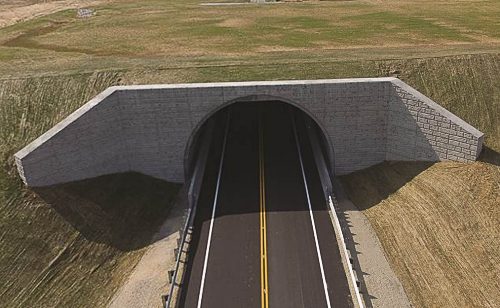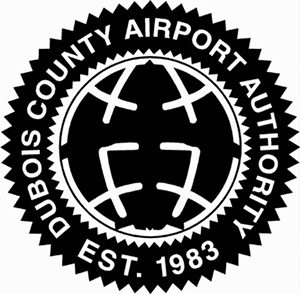When corporate customers expressed a desire to operate larger, longer-range jets at Huntingburg Regional (HNB) Airport, Manager Travis McQueen found a way to provide the extra runway length they would need.
When corporate customers expressed a desire to operate larger, longer-range jets at Huntingburg Regional (HNB) Airport, Manager Travis McQueen found a way to provide the extra runway length they would need.
 Keeping an open mind, McQueen and his team entertained a wide variety of strategies, including proposals to relocate nearby railroad tracks or even move the airport itself. In the end, though, they opted to build a tunnel under the existing airfield to create a thoroughfare for a nearby county highway, and then extend the main runway over that tunnel.
Keeping an open mind, McQueen and his team entertained a wide variety of strategies, including proposals to relocate nearby railroad tracks or even move the airport itself. In the end, though, they opted to build a tunnel under the existing airfield to create a thoroughfare for a nearby county highway, and then extend the main runway over that tunnel.
The first part of the project—building the tunnel and partially expanding Runway 9-27—is almost finished. The tunnel was constructed last summer, and the runway work is slated to wrap up in mid-September. When crews are done, the airport will have a runway that is 5,501 feet long and 100 feet wide, with improved drainage and updated lighting.
FAA is covering 90% of the estimated $13.2 million cost, and the county and state are each contributing 5%.
|
Project: Highway Tunnel & Runway Expansion Location: Huntingburg (IN) Regional Airport Owner/Operator: Dubois County Airport Authority Annual Operations: 14,000 Project Scope: Building tunnel for nearby highway; extending length of main runway from 5,000 to 5,501 ft., expanding width from 75 to 100 ft. Ancillary Projects: Lengthening taxiway; adding new runway & approach lights; improving runway drainage Estimated Cost: $13.2 million Funding: FAA 90%; state 5%; county 5% Design Approval/Land Acquisition: 2015 Tunnel Construction: Fall 2019-Sept. 2020
Runway Expansion: Associated Runway Closures: 2 days on & off during tunnel construction; about 3 months for runway expansion
Engineering Consultant: Main Contractor: Weddle Bros. Tunnel Supplier: Contech Construction Solutions
Electrical Supplier:
Geothermal & Soil Inspection: Key Benefits: Tunnel facilitates extension of main runway to accommodate larger corporate aircraft; new runway lights & PAPIs benefit all traffic Next Phase: Extend runway to 6,000 ft. in 4-5 years |
In four to five years, the airport plans to use the land directly above the new tunnel to extend the eastern end of Runway 9-27 to 6,000 feet. For now, the parcel is landscaped and serving as a runway safety area.
Why a Tunnel?
Located in southern Indiana, HNB logs approximately 14,000 operations a year. Several large companies have hangars and flight departments at the airport, including MasterBrand Cabinets, Jasper Engines and Transmissions, Kimball International, Best Home Furnishings and OFS Brands. All currently operate small or midsize corporate jets at the airport, but company officials have long wanted to leverage aircraft with more range, which would require a longer runway.
Therefore, the airport hired Woolpert, an engineering consulting company, to explore ways to make that happen. “Corporate jets using HNB now are able to use less than 65% of their useful load,” explains Curtis Brown, the firm’s Indiana aviation practice leader. “They have to make a pit stop to refuel when flying to Seattle, for instance.”
Woolpert engineers drew up more than 30 different plans representing a wide variety of strategies to provide a longer runway. Ultimately, the project team opted to build a tunnel and perform two separate extensions on Runway 9-27.
However, before the design was finalized and construction could begin, there were several roadblocks to hurdle—literally and figuratively. First, HNB had to acquire 41 acres of land just east of the current runway from a local property owner. That was accomplished in 2015, shortly after Woolpert’s final plan was approved.
Another big challenge was closing the county highway that would eventually pass through the tunnel. That required the project team to coordinate closely with the Dubois County Highway Department and local water, electric and telecommunications companies.
Because the road had to be closed for at least one year, the airport had to accommodate 12 landowners and various emergency departments that depended on it. To meet that challenge, Woolpert engineers designed a temporary seasonal road. Landowners regularly used it to access their property, and emergency personnel had access to it if necessary. Fortunately, that was not the case.
Satisfying all parties affected by the highway closure required close coordination with county officials and local emergency service departments. “I have to applaud everyone involved. The first priority was to serve the community,” says Brown. “We all sat together and hashed this out in 20 minutes! This was one of the best examples of interagency cooperation I have ever experienced in my nearly 30 years of doing this job.”
 Once construction of the tunnel began, Woolpert posted full-time inspectors on-site for the duration of the project. Brown, who is based in Indianapolis, visited almost weekly for regular program meetings with the prime contractor, Weddle Bros. “They did a great job meeting all the timelines,” he comments.
Once construction of the tunnel began, Woolpert posted full-time inspectors on-site for the duration of the project. Brown, who is based in Indianapolis, visited almost weekly for regular program meetings with the prime contractor, Weddle Bros. “They did a great job meeting all the timelines,” he comments.
Construction Challenges
Several surprises cropped up during site prep. For example, construction crews discovered an old creek bed that was still partially filled with water. To build over it, they filled the area with soil excavated from the north side of the airfield.
Workers also found a seam of coal, about 9 feet wide and 6 feet deep, running at a 45-degree angle under the headwalls of the tunnel site. Contractors dug up the coal to reach solid bedrock underneath, and struck a deal with adjacent landowners to use their soil as fill. “We took some of their soil on hills, and flattened the land for them after completing the digging,” states Jeff Busing, project manager for Weddle Bros. “This made it easier for them to plant crops.”
Once the site prep challenges were overcome, it was time to install the pre-engineered, precast concrete tunnel. “It was shipped to the site in two pieces, on two huge flatbed trucks. Then, two cranes were used to put it in place,” explains Busing. “This expedited the process significantly and minimized interruptions to airport services.”
It took crews two days to lower the large concrete pieces into a 15-foot-deep hole that was dug ahead of time. During this phase, the runway was closed from 8 a.m. to noon; opened from noon to 1 p.m.; closed again from 1 p.m. to 5 p.m. and reopened until 8 a.m. the next morning. Pilots were required to check in with the airport one day before their arrivals, but the limited operating schedule only lasted two days.
“This worked out pretty well,” McQueen reports. “Smaller prop planes did not have a problem avoiding the tall cranes at the end of the runway. However, the larger corporate jets landing at 130 knots needed the cranes’ booms lowered when they were coming in because these pilots requested that the whole runway be available to them. Overall, it worked out fine.”
After the two concrete pieces were in place, crews welded and sealed them together. Next, they backfilled the area with about 3 feet of stone and topped that with a layer of dirt.
The finished tunnel is 180 feet long, 19½ feet tall at the center point and 37½ feet from wall to wall. It is short enough so interior lighting was not needed, and wide enough to accommodate combines and other large farm equipment common in the area.
The road that passes through the tunnel has two 11-foot wide lanes, plus a 4-foot shoulder and a utility space of 3 feet.
Weddle Bros. crews completed most of the tunnel in June 2020, and finished related embankment and excavation work throughout the summer. Then, they paved and painted the tunnel-covered highway, which reopened for traffic in mid-September 2020.
Runway Improvements
The second major portion of the current project has required closing Runway 9-27 from mid-June 2021 to mid-September 2021. In addition to adding 501 feet of length and 25 feet of width, crews installed tiles to improve drainage and added new runway lights and precision approach path indicators (PAPIs).
The airport also extended a taxiway to serve the longer runway. During construction, HNB kept a section of the taxiway open to accommodate crop dusters that needed to spray nearby fields during the second week of July. “We made a portion of our taxiway available to them, but we required 24-hour advance notice of the times they intended to use the taxiway,” McQueen says, adding that pilots had to acknowledge/accept the risks associated with using a taxiway instead of a runway.

The taxiway section that remained open for crop dusters was 2,600 feet long, but most needed far less length than that. “They only fly for an hour at most, before returning to the airport for both aviation fuel and the liquid herbicide mixture they spray,” explains McQueen.
While aircraft operators eagerly anticipate the reopening of Runway 9-27, airport officials are already looking forward to extending it again.
“Both the tunnel itself and the land over it were engineered and constructed so that the runway could accommodate large corporate jets,” explains McQueen. “We just need more funding from the FAA to do it.”
If all goes according to plan, that extension will take the runway directly over the new tunnel and bring its total length to 6,000 feet—enough to allow large corporate aircraft leaving HNB to reach almost anywhere in the continental United States without stopping to refuel.


 facts&figures
facts&figures

